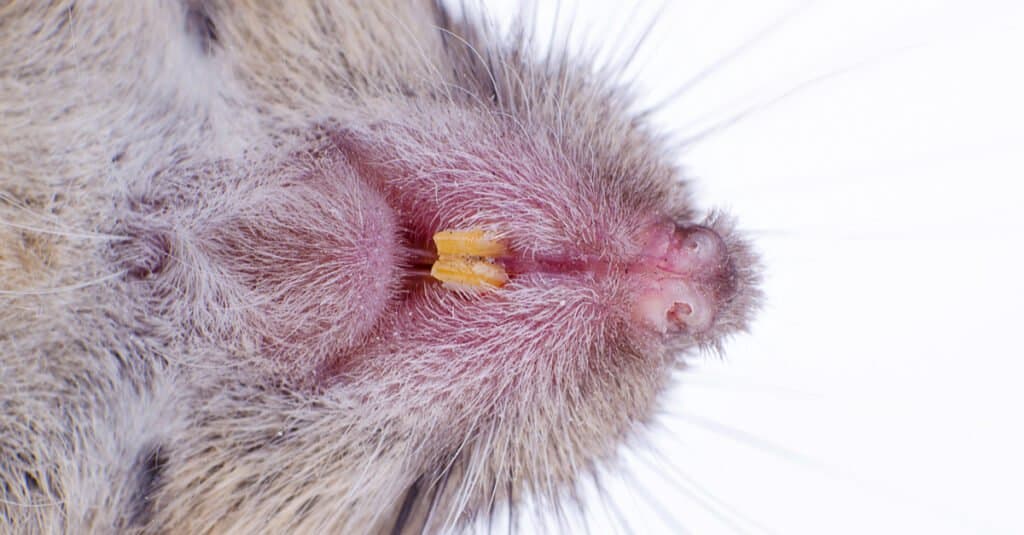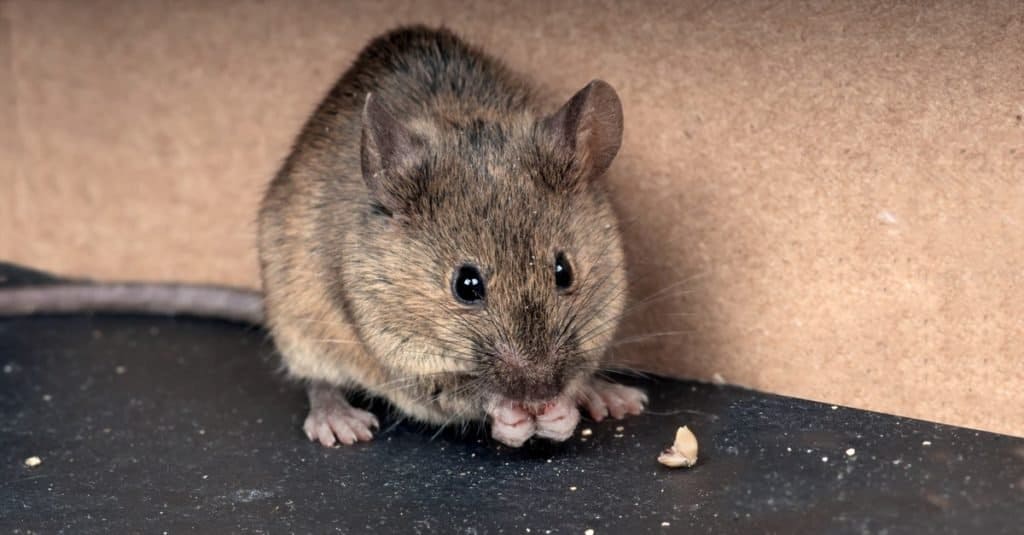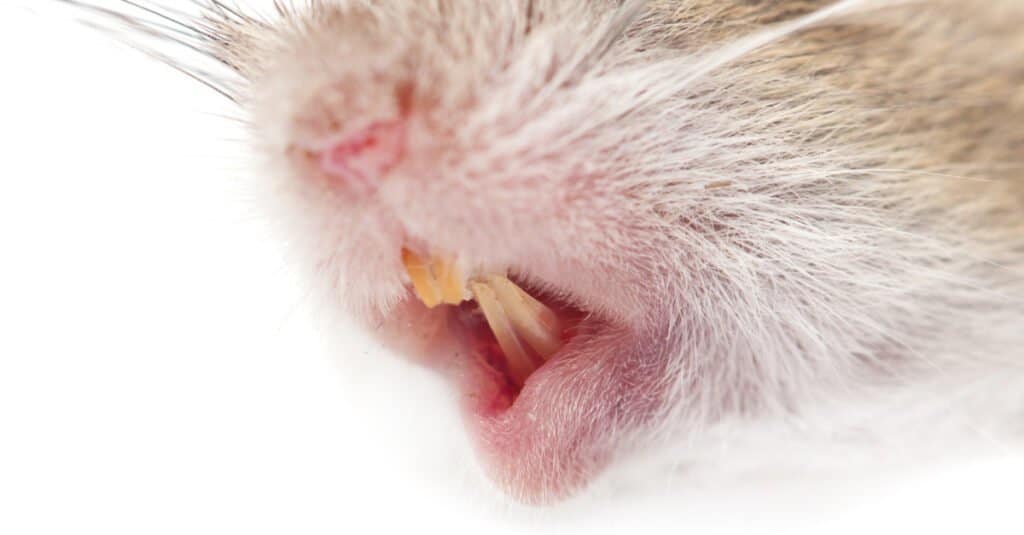Most people get the creeps whenever they come across mice. It’s understandable though, mice are known to infest many households, steal food, and chew on clothes and furniture. In fact, mice are one of the most common mammal pests in many residential areas. However, some species of mice can be turned into pets, such as the domesticated house mouse or the fancy mouse. Mice belong to the order Rodentia, and about 38 of its species lurk in the streets or homes around the globe.
Most people fear mice because of the diseases they can spread through their dirty urine, saliva, and droppings. Humans are also known to fear a mouse’s bite. This leads us to the question, what kind of teeth do mice have? And are their bites infectious?
What Kind of Teeth Do Mice Have?

Mice have incisors that continuously grow throughout their lifetime.
©Dmitro Derevyanko/Shutterstock.com
Mice have a set of teeth that are very much like other rodents’. Both of a mouse’s jaws have a single pair of extra-long incisors, each protruding endlessly. These incisors continuously grow as long as they are alive. These incisors are also stronger and tougher than human teeth. Mice have molars at the back of their mouths to help in chewing food.
When you take a look at a mouse, or simply any rodent, you might notice that one thing is common among their family: they have really long front teeth. This might even be a popular representation of mice around the world, even in animated cartoons. Like if pigs are represented with pink bodies and curly tails, then mice are always symbolized by their long front teeth.
Why Do Mice Keep on Chewing?
Since they have really long teeth, mice are required to constantly chew and gnaw on a wide range of things that include cardboard boxes, house furniture, wires, drawers, papers, even clothes and anything else made out of wood and chewable material. Chewing helps them wear their teeth down and keep them at a reasonable length. So the next time you see your wooden desk gnawed upon by a mouse, you already have an idea as to what they are trying to achieve!
Most rodents have the same dental structure and incisors that do not stop growing. In fact, their teeth can grow up to 0.3 millimeters each day, which is why they constantly need to grind it down. If these incisors get too long, it can cause them serious dental problems.
What Are Mice Teeth Made Of?
In each tooth, the front portion is formed of hard enamel, and the rear portion is made of softer dentine. As the rodent eats away chips of furniture or other things, the incisors grind against one another, causing the dentine to erode more quickly than the enamel.
How Strong Are Mice Teeth?

Mice teeth are more than half as hard as a pure diamond.
©IrinaK/Shutterstock.com
The teeth of both rats and mice are nearly the same strength based on the Mohs scale of hardness. Mice teeth score roughly 5.5, while human teeth are approximately just 5, and human fingernails are approximately 2.5. Diamonds score the hardest in this scale, hitting at 10. This means that mice teeth are more than half as hard as a pure diamond.
Mice are often mistaken as rats as they have somewhat similar anatomy and physical appearance. These two rodents are not the same, but when it comes to their teeth anatomy and dental formula, they obviously fall in the same family.
How Many Teeth Do Mice Have?

Mice have a total of 18 teeth.
©schankz/Shutterstock.com
Mice have 18 teeth in their mouth. Unlike most omnivorous mammals who have a complete set of incisors, canines, premolars, and molars, mice do not have canines. They, however, have four long incisors which protrude continuously. Mice typically have 18 teeth –four incisors, 2 premolars, and twelve molars. The usual dental formula shared by both rats and mice is as follows: incisors 1/1, canine 0/0, premolars 0/1, and molars 3/3.
The formula shown above describes how many teeth a mouse possesses in each side of the jaw –top, bottom, left, and right. There are a total of 18 teeth inside a mouse’s mouth, which include four incisors, two premolars in the middle of the bottom jaw, and six molars at the rear portion of the mouth.
Mice teeth are not as long as rats’, which makes their teeth marks on the furniture or other items they chew on less visible. Teeth marks left by a mouse barely look like a scratch on the surface as their tiny teeth can’t leave heavy-duty gouges.
What Do Mice Do with Their Teeth?
Mice generally use their sharp and elongated front teeth for self-defense, in excavating burrows, and chewing their food. Mice have a notoriously voracious appetite, and since they are omnivores who feed on various sets of food such as seeds, insects, grains, fruits, cheese, meat, and anything else they can forage and feast on, they use their back molars to further grind their food before digesting.
Do Mice Teeth Shed and Grow Back?
Mice are monophyodont, which means they are naturally born with only one set of teeth that they will be stuck with for the rest of their lives.
For us humans and for other mammals such as dogs, we are diphyodont, as we are born with a temporary set of teeth called baby teeth that shed when the right age comes. Then we grow new ones which will become our permanent set of teeth until we grow into adults.
Mice and rats, on the other hand, have the same set of teeth from when they are babies until they grow into adults.
Do Mice Bite?
Mice are not known to be aggressive mammals. In fact, they are elusive and would rather run away than attack humans. However, they can still bite humans when they feel threatened or cornered.
Infection is the main danger of mice bites, but mice bite can also be painful. Mice bite can also cause bacterial and viral infections and even allergic reactions in some people.
The photo featured at the top of this post is © schankz/Shutterstock.com
Thank you for reading! Have some feedback for us? Contact the AZ Animals editorial team.







